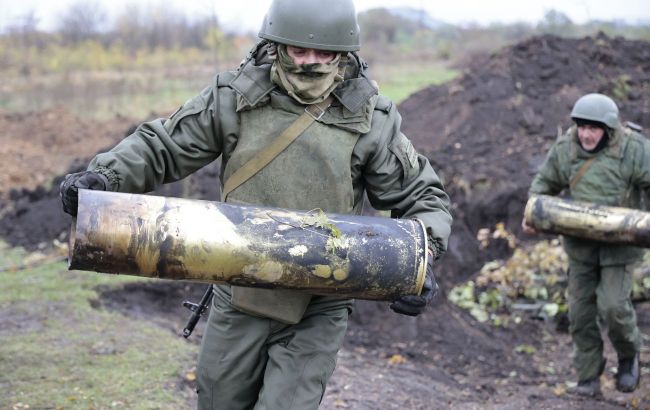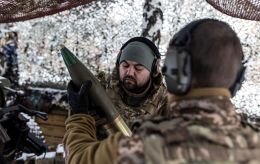Russia produces three times as many missiles for war with Ukraine as US and Europe
 Russia produces three times as many missiles for war with Ukraine as the West (Getty Images)
Russia produces three times as many missiles for war with Ukraine as the West (Getty Images)
Russia is producing almost three times more artillery ammunition than the US and Europe can supply to Kyiv, which is a crucial advantage before a new Russian offensive in Ukraine this year, according to CNN.
Russia is producing approximately 250,000 artillery munitions per month, or about 3 million per year, according to NATO intelligence estimates on Russian defense production provided to CNN, as well as sources familiar with Western attempts to arm Ukraine. In total, the US and Europe can only produce about 1.2 million munitions annually for shipment to Kyiv, a senior European intelligence representative told CNN.
American military aims to produce 100,000 artillery shells per month by the end of 2025 - less than half of Russia's monthly production - and even this figure is currently out of reach as the $60 billion funding for Ukraine has stalled in Congress, said a senior official.
"What we are in now is a production war," said a NATO senior official to CNN. "The outcome in Ukraine depends on how each side is equipped to conduct this war."
Official sources say Russia is currently producing about 10,000 shells per day, while from the Ukrainian side - only 2,000 per day. According to a European intelligence representative, in some places along the thousands of kilometers of front line, this ratio is even worse.
CNN notes that the shortage is observed at the most dangerous moment for military operations in Ukraine since Russia attacked Kyiv in February 2022. American funds for arming Ukraine have run out, and Republican opposition in Congress has effectively blocked funding.
Meanwhile, Russia recently captured the Ukrainian city of Avdiivka and is generally perceived to have the initiative on the battlefield. Ukraine is struggling not only with a shortage of ammunition but also with an increasingly severe shortage of manpower on the front lines.
The US and its allies have provided Ukraine with a range of modern systems, including the M-1 Abrams tank, and soon the F-16 fighter jets. But military analysts say the war will likely be won or lost based on who can produce more artillery shells.
"The number one issue that we’re watching right now is the munitions," said a NATO representative. "It’s those artillery shells, because that’s where Russia really [is] mounting a significant production advantage and mounting a significant advantage on the battlefield."
Russian military machine in full gear
According to a NATO representative, Russia operates artillery plants around the clock and without weekends, with 12-hour shifts. Currently, about 3.5 million Russians are working in the defense sector, compared to 2-2.5 million before the war. Russia also imports ammunition: last year Iran sent at least 300,000 artillery shells - "probably more than that," said an official - and North Korea provided at least 6,700 containers of ammunition, containing millions of shells.
"Russia has put everything they have in the game," said an intelligence representative. "Their war machine works in full gear."
A rough US equivalent would be if President Joe Biden invoked the Defense Production Act, said an American official, which gives the president the authority to order companies to rapidly produce equipment to support the country's national defense.
Competition with Putin's managed economy
European countries are trying to fill the deficit. Last month, a German defense company announced plans to open an ammunition factory in Ukraine, which, according to it, would produce hundreds of thousands of 155mm shells annually. In Germany, the same company has started construction of a new plant, which is expected to eventually produce about 200,000 artillery shells per year.
US and Western officials insist that while Russia has been able to launch its production lines partly because it has an advantage as a controlled economy under the control of an autocrat, capitalist Western countries will eventually catch up and produce higher-quality equipment.
"If you can actually control the economy, then you can probably move a little bit faster than other countries out there," said General Lieutenant Steven Basham, the deputy commander of US European Command, in an interview with CNN last week. But he said the West will have more power.
"The West is just starting their ramp-up of building the infrastructure to add in the munitions capability that is needed," he said.
When the money was still coming in, the US Army expanded artillery shell production in Pennsylvania, Iowa, and Texas.
"Russia’s output is 24/7. I mean, huge, immense," said one European lawmaker. "We should not underestimate their will to outlast us with patience, and with resilience."
Intelligence officials believe that neither side is ready to achieve any major successes in the near future, but overall mathematical calculations in the long term favor Moscow, especially if additional aid from the US does not materialize.
"It’s not going well, but it all depends," said one source familiar with Western intelligence. "If aid restarts and comes quick, all is not lost."
Weapon production in Ukraine
Russia has also recently attacked Ukraine's defense production with its long-range weapons.
"If we were talking about this last fall, we would have talked about how they were targeting critical infrastructure," the NATO official said. "Now what we see is some critical infrastructure targeting, but also a lot of targeting the Ukrainian defense industrial base."
According to a high-ranking NATO representative, Russia produces from 115 to 130 long-range missiles and from 300 to 350 single-use strike drones based on an Iranian model each month. Although Russia had thousands of long-range missiles in its arsenal before the war, today it fluctuates around 700, the official said.
Recently, Russians have retained this weaponry for use in large salvos, attempting to overwhelm Ukrainian anti-missile defenses. They've compensated for this increase in drone usage, dispatching on average four times as many drones per month as last winter.
Perhaps Russia's most glaring issue lies in tank and armored vehicle production. It churns out around 125 tanks a month, but the majority are old models refurbished. Approximately 86% of Russia's main battle tanks produced in 2023 were refurbished, as reported by a NATO representative. And while Russia has about 5000 tanks in storage, "probably a large percentage of those can’t be refurbished and are only good for cannibalizing part," said the official.
Moscow has lost at least 2700 tanks, more than doubling the total it initially deployed to Ukraine back in February 2022 when the invasion began.
Russia's 'transformed' economy
Officials are also closely monitoring Russia's economy for signs of how the interplay between an overstretched defense sector, Western sanctions, and Putin's efforts to ready his economy for war is affecting Russia's ability to sustain the conflict.
According to a NATO representative, the war has completely "transformed" Russia's economy compared to the post-Soviet period when oil was the leading sector. Now defense reigns as the largest sector of the Russian economy, with oil footing the bill.
This creates some long-term imbalances that are likely to be problematic for Russia, but for now, it's working, stated the NATO representative and Besham, a representative of the European Command of the United States.
"In the short term — say, the next 18 months or so — it may be unsophisticated, but it’s a durable economy," said the NATO representative.
The Pentagon is weighing whether to tap into this latest source of funding, but previously was hesitant to spend any money without assurances they would be reimbursed by Congress as they were drawing from Department of Defense reserves without a replenishment plan.
Ammunition for Ukraine
In February, Czech President Petr Pavel announced that his country had found 800,000 artillery shells for Ukraine's military needs: half a million of 155mm caliber and 300,000 of 122mm caliber. However, funds needed to be raised for their procurement.
The initiative was backed by Germany, Latvia, Lithuania, the Netherlands, Denmark, Canada, and France. Notably, on March 6, Germany allocated a three-digit million sum for purchasing ammunition. Norway, for its part, provided over $150 million for ammunition.
Following this, Czech President Petr Pavel said that the procured 800,000 artillery shells from third-party countries could be delivered to Ukraine within a few weeks.

